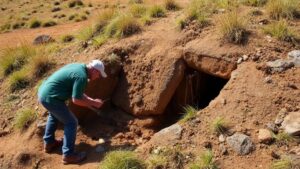Exploring Floodplains for Tribal Relics Exposed by Seasonal Rains
Exploring Floodplains for Tribal Relics Exposed by Seasonal Rains
Floodplains, the flat areas adjacent to rivers, serve as critical archaeological landscapes worthy of scholarly exploration, particularly concerning the artifacts of Indigenous tribes. These regions are dynamic ecosystems that facilitate the occurrence of seasonal rains, resulting in periodic flooding. Such events often expose tribal relics, providing invaluable insights into the cultural heritage of Indigenous communities. This article delves into the importance of floodplain archaeology and how seasonal rains can reveal hidden treasures that contribute to our understanding of past societies.
The Importance of Floodplain Archaeology
Floodplain archaeology is a specialized field that focuses on the study of human activity in wetland and riverine environments. These areas are essential for several reasons:
- Rich Geological Layers: Floodplains accumulate sediments over time, creating rich geological layers that can preserve artifacts and human skeletal remains.
- Natural Recovery of Artifacts: Seasonal flooding can wash away debris, enabling the exposure of long-buried artifacts and ecofacts that provide links to historical lifestyles.
- Ecological Significance: These landscapes are often biodiverse, supporting various flora and fauna that play a role in sustaining Indigenous cultures.
For example, the case of the Archaic period sites along the Mississippi River demonstrates how changing water levels can reveal hunting tools and ceremonial objects that characterize early Native American life. The artifacts recovered from these floodplains reflect not only daily life but also spiritual and communal practices.
Seasonal Rains and Their Role in Artifact Exposure
The interplay between climate patterns and archaeology is crucial. Seasonal rains lead to changes in water levels that can inadvertently expose archaeological materials. Understanding how rainfall patterns correlate with the geospatial distribution of these artifacts is essential for archaeologists. When rains cause floods, the water can undermine sediment layers, causing certain relics to surface. This exposure creates opportunities for archaeologists to document and recover artifacts that may have otherwise remained hidden.
For example, in 2019, significant flood events in the Midwest USA prompted archaeologists to investigate areas along riverbanks where they discovered pottery, tools, and habitation structures previously buried for centuries. Such findings underscore the need for ongoing monitoring of riverine landscapes before and after significant rainfall events.
Challenges and Ethical Considerations
Exploring floodplains for tribal relics poses several challenges and ethical considerations:
- Environmental Concerns: Excavating in flood-prone areas can disturb delicate ecosystems, impacting wildlife and plant communities.
- Intellectual Property: Artifacts must be studied and treated with respect to the associated Indigenous communities, ensuring that they are part of the narrative around their historical significance.
- Legal Framework: Laws such as the Native American Graves Protection and Repatriation Act (NAGPRA) require that any human remains or cultural items discovered be returned to the respective tribes.
Engaging with Indigenous leaders and community members during excavation projects is essential in navigating these challenges and fostering mutually beneficial partnerships. Such collaboration ensures that the insights derived from the findings honor rather than exploit the histories of the tribes involved.
Case Studies: Successful Discoveries in Floodplains
Several notable archaeological projects illustrate the rich potential of floodplain explorations:
- The Cahokia Mounds: Located in Illinois, this UNESCO World Heritage site exemplifies how understanding the relationship between seasonal flooding and settlement patterns can reveal the complexity of ancient Mississippian culture.
- Ocmulgee National Monument: This site in Georgia features artifacts uncovered through floodplain studies, including pottery and tools, highlighting the regions importance in Native American history.
These case studies demonstrate the interplay between environmental forces and archaeological artifacts, highlighting the relevance of floodplain studies in understanding Indigenous histories and cultures.
Conclusion: Actionable Takeaways for Archaeologists
As climate patterns continue to shift, the exploration of floodplains for tribal relics will only become more pertinent. Here are some actionable takeaways for archaeologists and researchers:
- Develop Monitoring Programs: Establish continuous monitoring of floodplain areas, identifying hotspots for potential archaeological finds as climate conditions change.
- Engage with Local Tribes: Collaborate with Indigenous communities to create holistic research frameworks that honor their input and knowledge.
- Document and Educate: Ensure that findings are well-documented and shared with public platforms, enlightening broader audiences about Indigenous heritage and the importance of preservation.
Through such proactive strategies, archaeologists can leverage seasonal rains as opportunities while maintaining ethical and ecological considerations in their pursuit of knowledge about tribal relics along floodplains.

